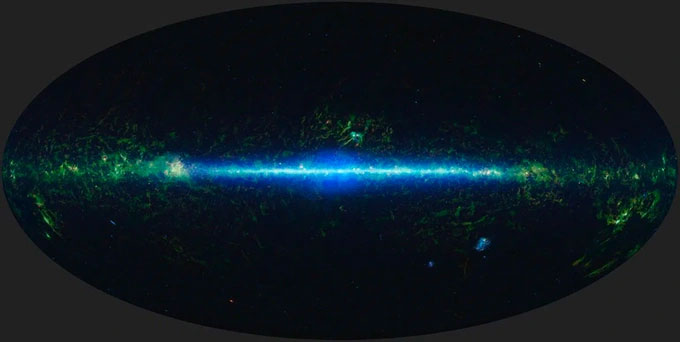After more than a decade of observing and monitoring the universe, NASA has released a short film showcasing the evolution of outer space, a place that is truly “busy.”
Over the past 12 years, the universe has undergone changes involving millions of stars, alongside black holes that are “devouring” all the matter they encounter (including light), and we can witness the dying moments of a star, asteroids, and comets.

This image was captured by the Wide-field Infrared Survey Explorer (WISE) telescope, covering the entire sky and revealing the positions of hundreds of millions of objects, as well as the amount of infrared light emitted by each object. (Photo: NASA).
These events stem from the observational efforts made by the NEOWISE mission.
This mission provides scientists with valuable information about the evolution of the universe over more than a decade.
The Near-Earth Object Wide-field Infrared Survey Explorer (NEOWISE) mission utilized the WISE space telescope to monitor asteroids and comets, including those that pose a potential threat to Earth.
WISE has identified and tracked near-Earth objects, collecting data on their sizes and other critical measurements. It has provided scientists with data from over 158,000 small celestial bodies, with more than 34,000 new discoveries.
All the data collected by NASA over more than 12 years has enabled the agency to recreate a short film depicting the evolution of our universe, the positions of hundreds of millions of objects, and the infrared light they emit into space.
A Cosmic Symphony
Accordingly, every six months, the WISE spacecraft completes half an orbit around the Sun, capturing images in all directions.
These images are then combined to create a map of the “entire universe”, displaying the position and brightness of hundreds of millions of objects.
Specifically, NASA has constructed 18 maps of the universe, allowing scientists to produce a film about the evolution of the universe after more than a decade.
Below is the time-lapse film from NASA’s NEOWISE mission, providing astronomy enthusiasts with the opportunity to see previously hidden brown dwarfs, a black hole consuming matter, a stellar nursery, or a dying star.
The time-lapse film from NASA’s NEOWISE mission.
From the video, we can see that distant objects have changed position or brightness over time, a phenomenon known as time-domain astronomy.
Scientist Amy Mainzer, a member of the NEOWISE project from the University of Arizona, Tucson, USA, stated in a release: “If you go outside and look at the night sky, it seems like nothing changes, but that’s not true. Stars shine and explode. Asteroids move at super-fast speeds, and black holes are tearing stars apart. The universe is a very busy place.”


















































